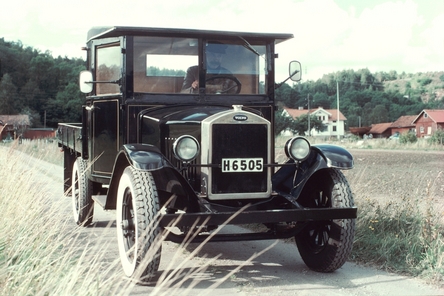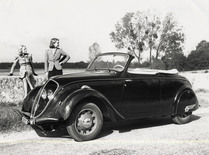
History of the Association
Early Years
The predecessor of the Association of Automobile Importers in Finland, the Association of Automobile Merchants, was founded on 27 January 1925. On 4 March 1955, the name of the association was changed to the Association of Automobile Importers in Finland, and it became the organization of the biggest car importers. At the same time, the bylaws of the association were rewritten.
The reasons behind the establishment of the organization after the World War I would appear familiar to car dealers today. Key reasons included the financial situation of car trade and the need to rationalize the sales of used vehicles. A third reason was the desire to strengthen joint marketing efforts in order to boost the sales of new motor vehicles.
 Soon
after its founding, the association placed car tax legislation on its
agenda. A Stamp Act had been passed in 1921 to tax the use of motor
vehicles. The first tax law on the use of automobiles was passed in
1929, and in 1957, the government made a proposal on temporary car tax.
The intention was to revoke the law and the car tax at the end of 1958.
However, the car tax has remained valid to this day, and it is one of
the highest in the EU.
Soon
after its founding, the association placed car tax legislation on its
agenda. A Stamp Act had been passed in 1921 to tax the use of motor
vehicles. The first tax law on the use of automobiles was passed in
1929, and in 1957, the government made a proposal on temporary car tax.
The intention was to revoke the law and the car tax at the end of 1958.
However, the car tax has remained valid to this day, and it is one of
the highest in the EU.
From the 1950s to the 1960s
In 1955, the key themes of the Association included promoting the interests of its members, representing its members towards the government and other organizations, and promoting the healthy import and sales of automobiles in Finland.
Another key task was to promote the development of healthy union principles and competition in Finland.
After World War II, the sales of new motor vehicles began in 1946. Due to the difficult economic situation and the lack of foreign currency, import volumes were insufficient to meet domestic demand. This led to claims that a large part of the sales of new motor vehicles had moved to the black market. In 1951, a four-member committee proposed the regulation of the import of passenger cars through licencing.
Licencing, foreign exchange regulation, and the bilateral agreements signed with some European countries led to the rapid growth of the import of motor vehicles from the Eastern bloc.
It should be noted that the sales of buses and trucks was deregulated
in 1949. The automobile trade strongly supported also the deregulation
of the sales of passenger cars, and at the beginning of the 1950, stated
that the annual import demand was 12,000 passenger cars and 9,000
trucks. The regulation of trade in new motor vehicles continued until
1962. The early days  were
hard also for relationships between members of the Association, because
the distribution of import licences, which the Association took part in
actively, caused tension between competitors.
were
hard also for relationships between members of the Association, because
the distribution of import licences, which the Association took part in
actively, caused tension between competitors.
Licences issued by the state, which also included provisions for the necessary foreign currency, were in practice distributed to car importers at the meeting of the Association’s Board of Directors. The situation was so difficult that the Association’s Board of Directors was chaired by Åke Roschier-Holmberg, who at the time was the Chairman of the Finnish Bar Association.
The importing of motor vehicles was deregulated in 1961 with
Finland’s associate membership in the European Free Trade Association
(EFTA). The number of imported vehicles increased rapidly, and the
growth was countered with significant tightening of car tax legislation
and motor vehicle fees. The reason behind the increasing control of car
importing was Finland’s current  account
deficit. The result was a series of increases in the already high car
tax. The import of motor vehicles from the Eastern bloc was eased on the
basis of bilateral agreements by, for example, adjusting regulations on
motor vehicle fees and payment periods.
account
deficit. The result was a series of increases in the already high car
tax. The import of motor vehicles from the Eastern bloc was eased on the
basis of bilateral agreements by, for example, adjusting regulations on
motor vehicle fees and payment periods.
Lobbying Established in the 1970s
The key goal of the Association was to deregulate car trade and reduce car taxation. However, especially in the 1970s, a major problem for the Association was the disagreement among its members about the way in which car taxation should be developed. Particularly the importers of motor vehicles manufactured in the Eastern bloc refused any proposals that would weaken their competitive advantages. Therefore, in addition to a reduction of car taxation, the Association’s proposal included a deductible portion defined in Finnish marks in order to secure the support of these importers.
None of the numerous attempts to reduce car taxation in Finland in the 1970s were successful. On the contrary, car taxation developed in the other direction during the decade. It was only after a member whose family was in the automobile trade was appointed as the Minister of Trade and Industry that the Association was able to receive the views on public finances of the Ministry of Finance and especially its budget department. This opened the door for lowering car taxation in Finland. The Association prepared calculations demonstrating that the reduction of car taxation would under certain conditions increase tax revenues. These calculations resonated well with state authorities and helped lay a foundation for a gradual decrease of car taxation.
 In
the 1960s and 1970s, it became a key duty of the Association to deliver
accurate, detailed traffic-related data to the authorities. The
Association gathered data on the registration of new vehicles from its
members, and categorized the data by manufacturer and delivered the data
to its members and the authorities. Thanks to the work of the
Association, there is reliable data on the registration of new vehicles
for decades prior to the establishment of the Finnish central motor
vehicle register Autorekisterikeskus.
In
the 1960s and 1970s, it became a key duty of the Association to deliver
accurate, detailed traffic-related data to the authorities. The
Association gathered data on the registration of new vehicles from its
members, and categorized the data by manufacturer and delivered the data
to its members and the authorities. Thanks to the work of the
Association, there is reliable data on the registration of new vehicles
for decades prior to the establishment of the Finnish central motor
vehicle register Autorekisterikeskus.
Other key activities of the Association included organizing national
car shows and more importantly, influencing public opinion. The rapid
radicalization that began in the 1960s fostered the foundation of, for
example, the association Enemmistö (‘majority’), which strongly opposed
and campaigned (with the support of the Finnish Broadcasting Company)
against private motoring and the acquisition and use of motor vehicles
by private
citizens. Automotive industry organizations, the oil industry and
insurance companies organized bulletins and a broad campaign to
distribute information about the need for private motoring and its
benefits to citizens. The Enemmistö association played a significant
role in, for example, the debate on the level of car taxation in
Finland.
Key Activities since the 1980s
In the 1980s, 1990s and 2000s, the key duties of the Association have remained unchanged: distributing correct information about the automotive industry and traffic, providing information to the authorities, and cooperating with the authorities, research institutes and organizations. Naturally, one goal has been to ensure that the views of the automotive industry are taken into consideration in the drafting of legislation and regulations. A key element of lobbying has been the distribution of accurate, research-based information that provides new perspectives. This work has been based on research projects carried out in cooperation with different research institutes and universities. International research has been utilized increasingly thanks to closer contacts with foreign associations of automobile importers, international automotive industry organizations and car manufacturers. Regulation and cooperation with the authorities and automotive organizations has developed significantly, with the common goal of reducing the negative impacts of traffic, improving traffic safety, and above all, solving environmental issues.
In addition, the condition of the Finnish road network has become a focus area especially since the 1980s, both as an important element of traffic safety and as a key growth factor for the Finnish economy.
In the 1980s, the Association played a key role in the removal of anti-competitive practices and special benefits given to the import of motor vehicles from the Eastern bloc. Also regulations related to consumer protection legislation and fair play rules in the industry have been strengthened.
Technical legislation governing road transport had a prominent role in the Association’s activities during the 1970s, 1980s and 1990s, when the Association’s technical committees for both heavy and light vehicles cooperated with the traffic authorities in drafting new legislation. After Finland joined the EU, the amount of national legislative work has decreased considerably.
During the past 30 years, the main objectives of the Association have included reducing inland’s
car taxation (which is exceptionally high in Europe), simplifying the
car taxation system, and renewing Finland’s motor vehicle population
while taking environmental and safety issues into consideration. The
Association has been very successful in pursuing these goals. In order to better represent the focus and operating environment of members, the name of the association was changed to the Association of Automobile Industry in Finland in June 2017.
The Association has considered it important to distribute accurate and research-based traffic-related data, as well as to participate in different committees set up by the authorities. Up-to-date and correct industry-related information, transparency and honesty are key factors for the Association’s credibility and for the approval of its views among the public and the authorities. Especially the latest research data received through international contacts has been useful in these activities. The success of the Association in these activities remains to be judged by outsiders.

